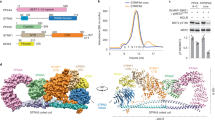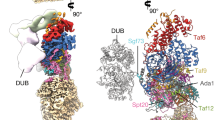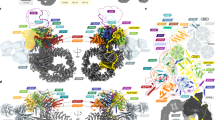Abstract
STAT proteins are a family of eukaryotic transcription factors that mediate the response to a large number of cytokines and growth factors. Upon activation by cell-surface receptors or their associated kinases, STAT proteins dimerize, translocate to the nucleus and bind to specific promoter sequences on their target genes. Here we report the first crystal structure of a STAT protein bound to its DNA recognition site at 2.25 Å resolution. The structure provides insight into the various steps by which STAT proteins deliver a response signal directly from the cell membrane to their target genes in the nucleus.
This is a preview of subscription content, access via your institution
Access options
Subscribe to this journal
Receive 51 print issues and online access
$199.00 per year
only $3.90 per issue
Buy this article
- Purchase on Springer Link
- Instant access to full article PDF
Prices may be subject to local taxes which are calculated during checkout




Similar content being viewed by others
References
Darnell, J. E. J STATs and gene regulation. Science 277, 1630–1635 (1997).
Ihle, J. N. STATs: Signal transducers and activators of transcription. Cell 84, 331–334 (1996).
Pellegrini, S. & Dusanter-Fourt, I. The structure, regulation and function of the Janus kinases (JAKs) and the signal transducers and activators of transcription (STATs). Eur. J. Biochem. 248, 615–633 (1997).
Kumar, A., Commane, M., Flickinger, T. W., Horvath, C. M. & Stark, G. R. Defective TNF-α-induced apoptosis in STAT1-null cells due to low constitutive levels of caspases. Science 278, 1630–1632 (1997).
Pfeffer, L. M. et al. Stat3 as an adaptor to couple phosphatidylinositol 3-kinase to the IFNAR1 chain of the type I interferon receptor. Science 276, 1418–1420 (1997).
Xu, X., Sun, Y.- & Hoey, T. Cooperative DNA binding and sequence-selective recognition conferred by the STAT amino-terminal domain. Science 273, 794–797 (1996).
Vinkemeier, U. et al. DNA binding of in vitro activated Stat1α, Stat1β and truncated Stat1: interaction between NH2-terminal domains stabilizes binding of two dimers to tandem DNA sites. EMBO J. 15, 5616–5626 (1996).
Horvath, C. M., Wen, Z. & Darnell, J. E. J ASTAT protein domain that determines DNA sequence recognition suggests a novel DNA-binding domain. Genes Dev. 9, 984–994 (1995).
Shuai, K. et al. Interferon activation of the transcription factor Stat91 involves dimerization through SH2-phosphotyrosyl peptide interactions. Cell 76, 821–828 (1994).
Wen, Z., Zhong, Z. & Darnell, J. E. J Maximal activation of transcription by Stat1 and Stat3 requires both tyrosine and serine phosphorylation. Cell 82, 241–250 (1995).
Caldenhoven, E. et al. Stat3β, a splice variant of transcription factor Stat3, is a dominant negative regulator of transcription. J. Biol. Chem. 271, 13221–13227 (1996).
Schaeffer, T. S., Sanders, L. K. & Nathans, D. Cooperative transcriptional activity of Jun and Stat3β, a short form of Stat3. Proc. Natl Acad. Sci. USA 92, 9097–9101 (1995).
Vinkemeier, U., Moarefi, I., Darnell, J. E. J & Kuriyan, J. Structure of the amino-terminal protein interaction domain of STAT-4. Science 279, 1048–1052 (1998).
Wagner, B. J., Hayes, T. E., Hoban, C. J. & Cochran, B. H. The SIF binding element confers sis/PDGF inducibility onto the c-fos promoter. EMBO J. 9, 4477–4484 (1990).
Fu, X.-Y., Schindler, C., Improta, T., Aebersold, R. & Darnell, J. E. J The proteins of ISGF-3, the interferon α-induced transcriptional activator, define a gene family involved in signal transduction. Proc. Natl Acad. Sci. USA 89, 7840–7843 (1992).
Herzberg, O. & James, M. N. G. Structure of the calcium regulatory muscle protein troponin C at 2.8 Å resolution. Nature 313, 653–659 (1985).
Sundaralingam, M., Bergstrom, R., Strasburg, G. & Rao, S. T. Molecular structure of troponin C from chicken skeletal muscle at 3 angstrom resolution. Science 227, 945–948 (1985).
Eck, M. J., Shoelson, S. E. & Harrison, S. C. Recognition of a high-affinity phosphotyrosyl peptide by the Src homology-2 domain of p56lck. Nature 362, 87–91 (1993).
Lamb, P. et al. STAT protein complexes activated by interferon-c and gp130 signalling molecules differ in their sequence preferences and transcriptional induction properties. Nucleic Acids Res. 23, 3283–3289 (1995).
Mikita, T., Campbell, D., Wu, P., Williamson, K. & Schindler, U. Requirements for interleukin-4-induced gene expression and functional characterization of Stat6. Mol. Cell. Biol. 16, 5811–5821 (1996).
Seidel, H. M. et al. Spacing of palindromic half sites as a determinant of selective STAT (signal transducers and activators of transcription) DNA and transcriptional activity. Proc. Natl Acad. Sci. USA 92, 3041–3045 (1995).
Müller, C. W., Rey, F. A. & Harrison, S. C. Comparison of two different DNA-binding modes of the NF-κB p50 homodimer. Nature Struct. Biol. 3, 224–227 (1996).
Kuriyan, J. & Cowburn, D. Modular peptide recognition domains in eukaryotic signaling. Annu. Rev. Biophys. Biomol. Struct. 26, 259–288 (1997).
Heim, M. H., Kerr, I. M., Stark, G. R. & Darnell, J. E. J Contribution of Stat SH2 groups to specific interferon signaling by the Jak–Stat pathway. Science 267, 1347–1349 (1995).
Stancato, L. F., David, M., Carter-Su, C. & Larner, A. C. Preassociation of Stat1 with Stat2 and Stat3 in separate signalling complexes prior to cytokine stimulation. J. Biol. Chem. 271, 4134–4137 (1996).
Stahl, N. et al. Choice of STATs and other substrates specified by modular tyrosine-based motifs in cytokine receptors. Science 267, 1349–1353 (1995).
Gerhartz, C. et al. Differential activation of acute phase response factor/Stat3 and Stat1 via the cytoplasmic domain of the interleukin 6 signal transducer gp130. J. Biol. Chem. 271, 12991–12998 (1996).
Horvath, C. M., Stark, G. R., Kerr, I. M. & Darnell, J. E. J Interactions between STAT and non-STAT proteins in the interferon-stimulated gene factor 3 transcription complex. Mol. Cell. Biol. 16, 6957–6964 (1996).
Müller, C. W., Rey, F. A., Sodeoka, M., Verdine, G. L. & Harrison, S. C. Structure of the NF-κB p50 homodimer bound to DNA. Nature 373, 311–317 (1995).
Ghosh, G., Van Duyne, G., Ghosh, S. & Sigler, P. B. The structure of NF-κB p50 homodimer bound to a κB site. Nature 373, 303–310 (1995).
Cramer, P., Larson, C. J., Verdine, G. L. & Müller, C. W. Structure of the human NF-κB p52 homodimer–DNA complex at 2.1 Å resolution. EMBO J. 16, 7078–7090 (1997).
Chen, Y.-Q., Ghosh, S. & Ghosh, G. Anovel DNA recognition mode by the NF-κB p65 homodimer. Nature Struct. Biol. 5, 67–73 (1998).
Chen, F. E., Huang, D.-B., Chen, Y.-Q. & Ghosh, G. Crystal structure of p50/p65 heterodimer of transcription factor NF-κB bound to DNA. Nature 391, 410–413 (1998).
Müller, C. W. & Herrmann, B. Crystallographic structure of the T domain–DNA complex of the Brachyury transcription factor. Nature 389, 880–884 (1997).
Otwinowski, Z. & Minor, W. Processing of X-ray diffraction data collected in oscillation mode. Meth. Enzymol. 276, 307–326 (1997).
Collaborative Computational Project Number 4. The CCP4 suite: Programs for protein crystallography. Acta Crystallogr. D 50, 760–776 (1994).
Fortelle, E. d. L. & Bricogne, G. Maximum-likelihood heavy-atom parameter refinement for the multiple isomorphous replacement and multiwavelength anomalous diffraction methods. Meth. Enzymol. 276, 472–494 (1997).
Richardson, J. S. & Richardson, D. C. Interpretation of electron density. Meth. Enzymol. 115, 189–206 (1985).
Jones, T. A., Zhou, J. Y., Cowan, S. W. & Kjeldgaard, M. Improved methods for building protein models in electron density maps and the location of errors in these models. Acta Crystallogr. A 47, 110–119 (1991).
Brünger, A. T. X-PLOR version 3.1. A system for X-ray crystallography and NMR (Yale University Press, New Haven, CT, (1992)).
Brünger, A. T. Free R value: A novel statistical quantity for assessing the accuracy of crystal structures. Nature 355, 472–475 (1992).
Laskowski, R. A., MacArthur, M. W., Moss, D. S. & Thornton, J. M. PROCHECK: a program to check the stereochemical quality of protein structures. J. Appl. Crystallogr. 26, 283–291 (1993).
Higgins, D. G., Thompson, J. D. & Gibson, T. J. Using CLUSTAL for multiple sequence alignments. Meth. Enzymol. 266, 383–402 (1996).
Chen, L., Glover, J. N. M., Hogan, P. G., Rao, A. & Harrison, S. C. Structure of the DNA-binding domains from NFAT, Fos and Jun bound specifically to DNA. Nature 392, 42–48 (1998).
Carson, M. Ribbons 2.0. J. Appl. Crystallogr. 24, 958–961 (1991).
Nichols, A., Bharadwaj, R. & Honig, B. GRASP—graphical representation and analysis of surface properties. Biophysics J. 64, A166–A166 (1993).
Acknowledgements
We thank our colleagues for their help and for discussions, particularly C. Petosa for help with refinement, A. Perrakis for help with program Sharp, and C. Petosa, F. Baudin, J. Grimes and P.Cramer for comments on the manuscript; we also thank members of the EMBL/ESRF Joint Structural Biology Group, particularly B. Rasmussen, J. Grimes and J. Lescar at ID2, A. Thompson, V. Stojanoff and G. Leonard at BM14, and W. Burmeister and S. Wakatsuki at ID14-3, for their support; and R. Eritja for oligonucleotide synthesis. This project was supported by an institutional fellowship of the European Union and a short-term EMBO fellowship to S.B.
Author information
Authors and Affiliations
Corresponding author
Rights and permissions
About this article
Cite this article
Becker, S., Groner, B. & Müller, C. Three-dimensional structure of the Stat3β homodimer bound to DNA. Nature 394, 145–151 (1998). https://doi.org/10.1038/28101
Received:
Accepted:
Published:
Issue Date:
DOI: https://doi.org/10.1038/28101
This article is cited by
-
PROTAC’ing oncoproteins: targeted protein degradation for cancer therapy
Molecular Cancer (2023)
-
A selective small-molecule STAT5 PROTAC degrader capable of achieving tumor regression in vivo
Nature Chemical Biology (2023)
-
Identification of novel STAT3 inhibitors for liver fibrosis, using pharmacophore-based virtual screening, molecular docking, and biomolecular dynamics simulations
Scientific Reports (2023)
-
Identification of marine natural product Pretrichodermamide B as a STAT3 inhibitor for efficient anticancer therapy
Marine Life Science & Technology (2023)
-
Role of EGFR and FASN in breast cancer progression
Journal of Cell Communication and Signaling (2023)
Comments
By submitting a comment you agree to abide by our Terms and Community Guidelines. If you find something abusive or that does not comply with our terms or guidelines please flag it as inappropriate.



